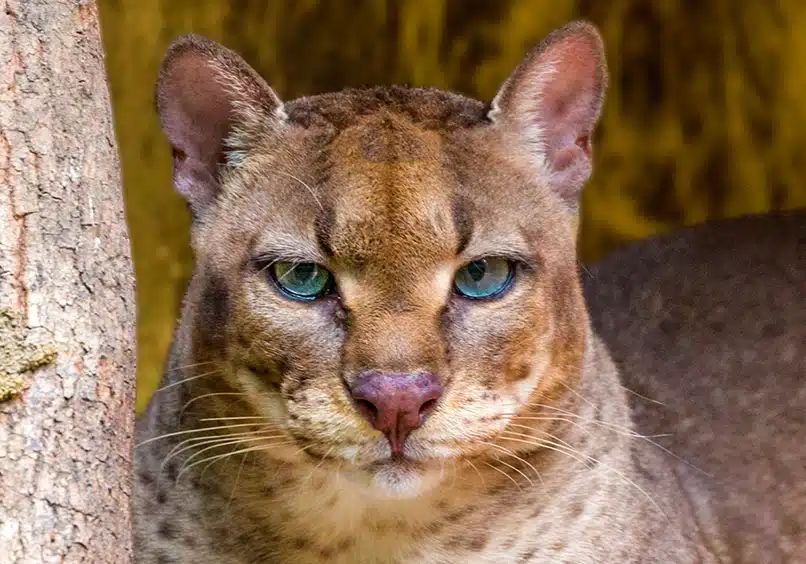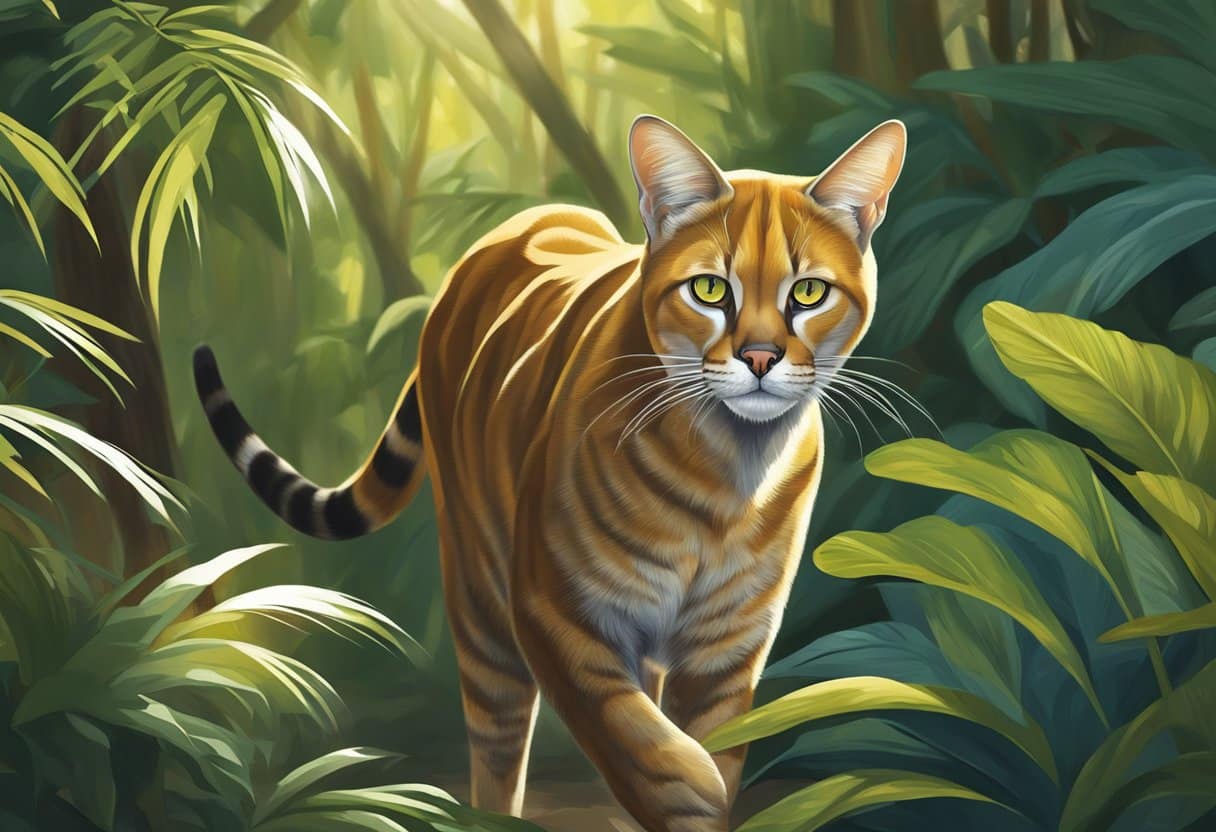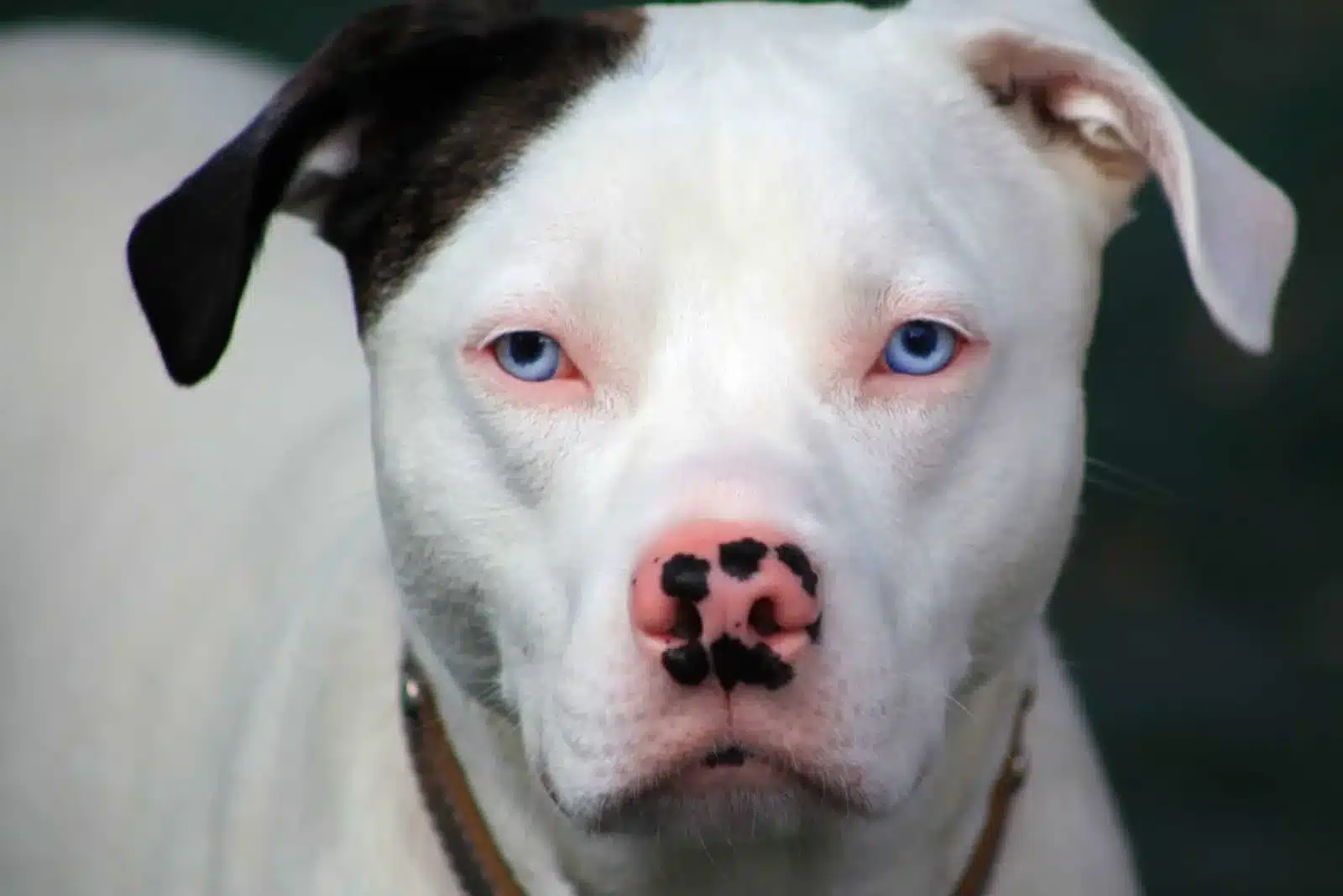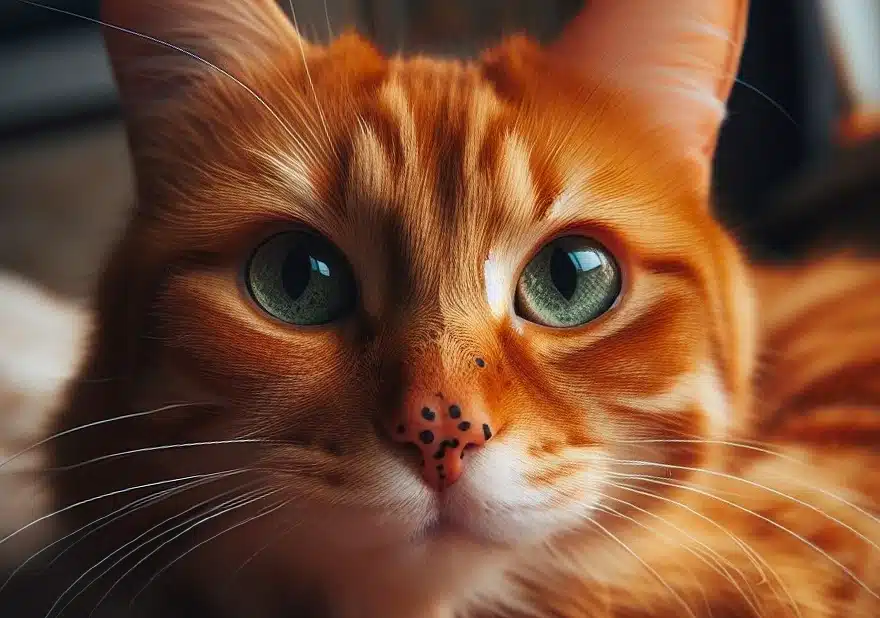African Golden Cat: Africa’s Lesser-Known Wildcat (Facts and Photos)
Ads Disclosure ?

The African golden cat, scientifically known as Caracal aurata, is one of the elusive wild felines native to the dense rainforests of West and Central Africa. This medium-sized cat has adapted to a life under the canopy, with a physique that is robust and a temperament that shies away from human activity. Despite its name, the cat’s coat color is not always golden; it exhibits a range of hues from chestnut or reddish-brown to slate grey. Notably, this species exhibits two distinct color morphs and a variety of patterns across individuals, displaying the fascinating diversity of nature’s adaptability.
Classified as vulnerable by conservationists, the African golden cat faces significant threats from human activities, including deforestation and bushmeat hunting which have led to a decline in its population. The species has a close genetic relationship to both the caracal and the serval, sharing similar ecological niches and morphological features. Yet, it stands out due to its distinct behavior and habitat preferences, typically avoiding open areas and favoring the concealment provided by dense forest undergrowth.
Knowledge about this species is far from complete due to its reclusive nature.
Jump To Section
Taxonomy and Classification
The African Golden Cat, scientifically known as Caracal aurata, is a distinct member of the family Felidae, holding its own unique position within the wildcat lineage.
Scientific Name and Family
Caracal aurata, commonly known as the African Golden Cat, belongs to the family Felidae, which comprises all cat species. Traditionally, this species was classified under the genus Profelis, but it has since been reclassified to the genus Caracal. This alignment suggests a close kinship with the caracal and the serval.
Subspecies and Evolution
While Caracal aurata does not have widely recognized subspecies, research indicates a rich evolutionary history. The species has evolved adaptations specifically suited to the dense rainforest habitats of West and Central Africa, developing traits that differentiate it from other felids.
Traits and Evolutionary Adaptations:
| Trait | Description |
|---|---|
| Coat Coloration | Ranges from golden to reddish-brown with variable spotting and striping. |
| Skull Structure | Exhibits a semi-complete postorbital closure. |
| Limb Proportions | Short, stocky limbs, allowing for arboreal hunting. |
These evolutionary traits have enabled African Golden Cats to become highly specialized hunters within their ecosystem.
Physical Characteristics
The African golden cat is a robust and elusive feline, noted for its distinctive coat and significant variation in size.
Size and Weight
The African golden cat exhibits considerable size variation, with body length typically ranging from 61 to 101 cm (24 to 40 in). The tail adds an additional 16 to 46 cm (6.3 to 18.1 in) to its overall length. Adult cats exhibit a height of about 38 to 55 cm (15 to 22 inches) at the shoulder. Weight can vary significantly, with these cats generally tipping the scales between 5.5 and 16 kg (12.1 to 35.3 lbs).
Coat and Patterns
Their coat’s base coloring can be either a striking reddish-brown or a more subdued grey, often marked with distinct darker spots or faint horizontal striping. The belly is typically a lighter color, contrasting with the rest of the body. Variations in the coat and patterns help the African golden cat blend into the dense forests it inhabits, serving as effective camouflage.
Distinctive Features
These felines have a rounded face that appears small in proportion to their body. Another characteristic feature is their large paws which, along with their sturdy legs, suggest a powerful build well-suited to their habitat. Contrary to many other cats, the African golden cat has a relatively short tail, which is less than half the length of its body.

Behavior and Lifestyle
The African golden cat is known for its elusive and private nature, leading a solitary existence across the central African forests. Its behavior varies from nocturnal to crepuscular, adapting to different conditions for survival and hunting.
Activity Patterns
This feline predominantly displays nocturnal behavior, but it can also be active during dawn and dusk, known as crepuscular periods. The adaptation to these activity patterns aids in avoiding the heat of the day and increases efficiency in hunting.
Social Structure
The African golden cat is a solitary animal, coming together with others only during breeding seasons or when a mother is raising her young. Their interactions with other cats are limited, emphasizing a lifestyle that revolves around independence.
Hunting and Diet
The diet of the African golden cat is extensive, including a range of prey such as birds, rodents, small mammals, and sometimes even small monkeys. They have been noted for their hunting prowess, able to take on animals larger than themselves, which makes them key predators within their ecosystem. Hunting strategies are geared towards stealth and surprise, utilizing the dense forest underbrush for cover.
Habitat and Distribution
The African golden cat is strongly associated with the rainforests of West and Central Africa, where it occupies a range of forested habitats and displays a marked adaptability in its geographical spread.
Geographic Range
The African golden cat (Caracal aurata) is most commonly found across Central Africa with its presence extending to parts of West and East Africa. Notably, it spans a range from Senegal in the west to Uganda and Kenya in the east, encompassing countries like Ghana, Cameroon, and Nigeria. This elusive feline is also found in Gabon, Guinea, and the Central African Republic. The species shows a minimal distribution through the Congo basin, indicating its adaptability to various regional ecosystems.
Habitat Preferences
Preferring dense tropical forests, the African golden cat often resides in areas that offer abundant cover and rich prey populations. These habitats include bamboo forests and other densely forested areas. While the species has shown a degree of adaptability, their preference leans heavily towards regions with high humidity and significant undergrowth, which are characteristic of the equatorial forest belt. Despite the loss of habitat due to deforestation, the African golden cat continues to survive in secondary forests and has been occasionally spotted in more open areas neighboring forests.

Conservation Status
The African golden cat is grappling with multiple environmental challenges that have led to its status as a vulnerable species listed by the IUCN Red List.
Threats to Survival
The primary threats to the African golden cat include deforestation, habitat loss, and fragmentation due to human activities such as logging, mining, and construction. These activities reduce the living spaces of these wild cats, limiting their ability to hunt and breed. Their habitats are not only diminishing but are becoming increasingly isolated from each other, complicating gene flow and population stability.
- Deforestation: Significant owing to logging and land clearance for agriculture.
- Mining: Leads to habitat destruction and pollution.
- Construction: Infrastructure development further fragments habitats.
IUCN Red List
Listed as Vulnerable by the International Union for Conservation of Nature (IUCN), the African golden cat faces a high risk of extinction in the wild. Variations in coat color, from reddish-brown to melanistic forms which may appear spotted, black, or even leopard-like, have little impact on their classification. It’s their population numbers, impacted by the aforementioned threats, that dictate their conservation status. The classification of ‘Vulnerable’ underscores the importance of international efforts to enhance their survival and mitigate the risks they face.
Reproduction and Lifespan
The African golden cat exhibits a secretive breeding pattern and a lifespan that varies significantly between wild and captive conditions.
Breeding Behavior
The African golden cat is elusive, and this extends to its reproduction behaviours. Mating rituals are infrequently observed, but it is known that these cats are solitary and seek partners solely for reproduction. In captivity, they reveal a gestation period lasting approximately 75 days.
Development and Maturation
Kittens are born in small litters, usually consisting of one to two offspring after the gestation period. They are weaned at around six weeks. Females reach sexual maturity by 11 months of age, while males mature later, around 18 months. In captivity, African golden cats have a longer lifespan of up to 15 years, whereas their expectancy in the wild remains uncertain due to their concealed lifestyle within dense forests. Tail length, while not directly related to reproduction or development, ranges from 16 to 46 centimeters and does not significantly impact these processes.
Research and Studies
Research and studies on the African golden cat (Caracal aurata, previously known as Profelis aurata) have been pivotal in understanding its ecology and conservation needs.
Current Research Initiatives
Current research initiatives are looking into various aspects of the African golden cat’s life, particularly its behavior, habitat preferences, and response to environmental pressures. The Felidae Conservation Fund is actively involved in studying activity patterns, which suggest that the golden cat is mainly nocturnal and adapts to different types of forest environments including primary forests, secondary growth, and logged forests with dense understory.
Researchers are also focusing on the distribution of these elusive felines. The International Society for Endangered Cats highlights that their presence is confined to tropical Africa, with populations in west-central Africa and along the west coast to the north. As this cat is the only forest-dependent wildcat in Africa, understanding its geographical range is essential for its conservation.
Importance of Camera Traps
Camera traps are an indispensable tool in the study of the African golden cat. These remote devices offer non-invasive insight into the secretive lives of these animals, recording their activities without human interference. The use of camera traps has been revolutionary, for instance, in dispelling myths about the cat’s kinship, confirming its genetic closeness to the caracal.
Through camera trap images, researchers can gather data on population density, behavior patterns, and interaction with other species. This information is crucial in planning targeted conservation strategies. Camera trap studies have also been integral in identifying habitat requirements of the African golden cat, ensuring that critical areas are recognized and protected.
Cultural and Economic Implications
The African golden cat holds a unique place in local folklore and can influence the economic stability of communities within its habitat.
In Folklore and Culture
The African golden cat often appears as a symbol in regional folklore, representing various spiritual beliefs and practices. In some cultures, they are depicted as guardians of the forest, a role that underlines their importance in the local ecosystem and imbues them with a sacred status. The cat’s elusive nature contributes to its mystique, but also presents challenges in fully understanding its cultural significance.
Impact on Local Communities
Economically, the African golden cat influences local communities primarily through bushmeat hunting. While the sale of bushmeat can be a source of income, this practice threatens the cat’s survival. In areas where conservation awareness is growing, there’s potential for eco-tourism to replace bushmeat income, providing an alternative livelihood for communities and a means to protect local felids.
The relationship between domestic cats and African golden cats is less direct, but diseases transmitted from domestic species can have detrimental effects on wild populations. The African golden cat’s role as a predator also impacts local wildlife populations and, in turn, the greater ecosystem’s health, which is essential for agriculture and the sustenance of the communities. Being a relative of the serval and other felids, conservation strategies aimed at the African golden cat may benefit these species as well, furthering the ecological and economic impact on the region.
Frequently Asked Questions

What is the diet of the African golden cat?
The African golden cat primarily feeds on small mammals, such as rodents and small antelopes, along with birds, tree hyraxes, monkeys, and at times, fish. Their hunting strategies and prey of choice adapt depending on the availability within their habitat.
How does the size of the African golden cat compare to other wild cats?
African golden cats are medium-sized when measured against other wild cats. They typically weigh between 5.5-16 kilograms, with body length ranging from 61 to 101 centimeters, making them smaller than a leopard but larger than a domestic cat.
What are the primary threats that contribute to the African golden cat being endangered?
Deforestation, habitat fragmentation, and bushmeat hunting are the main threats to the African golden cat’s survival. These activities not only reduce their natural habitation but also their prey availability, posing a significant risk to their population.
In which habitats can African golden cats primarily be found?
These cats are predominantly found in the dense tropical rainforests and montane forests of Central and West Africa. They adapt well to their often dark and dense forest environments, which provide cover and a rich hunting ground.
How is the African golden cat different from the Asian golden cat?
Though sharing similar names due to their coat color, the African golden cat (Caracal aurata) and the Asian golden cat (Catopuma temminckii) differ genetically and geographically. The African species is native exclusively to Africa and has a different physical build and behavioral patterns compared to its Asian counterpart.
What conservation efforts are in place to protect the African golden cat population?
Several conservation efforts, including legal protection, habitat conservation programs, and furthering research to understand the species’ ecology and behavior, are in place. International organizations classify the African golden cat as vulnerable, prompting actions to mitigate threats and protect their remaining habitats.








